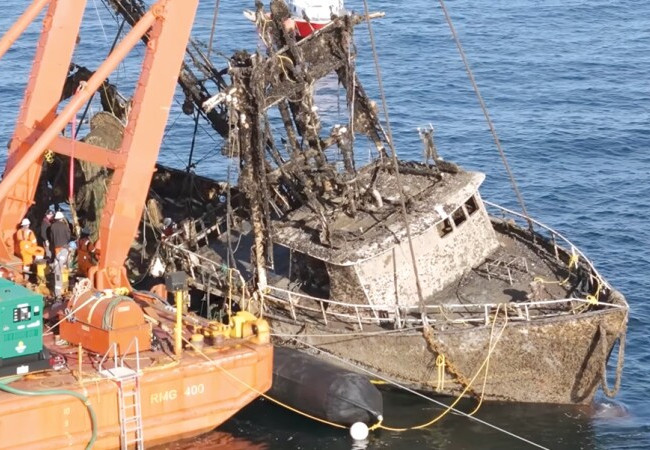Artificial Reefs Economics
Cost of Building Reefs

According to a survey conducted by the Division in 1993 and 1994, an average of $2.2 million is expended annually to construct and manage New Jersey's ocean reefs. The management portion of the project, which includes the salaries of State marine biologists who select reef sites, coordinate construction activities, and conduct biological and harvest surveys, and the costs of operating a research vessel and sampling equipment, amounts to approximately $215,000 each year. Funding for management is composed of $161,000 in federal Sportfish Restoration Funds, which are obtained from excise taxes on recreational fishing tackle, and $54,000 in state funding.
Each year, an average of $1,978,000 in reef construction costs are donated from a variety of sources. The preparation, cleaning, and towing of ships and barges destined for the reefs is paid for by vessel donors and by donations from anglers and divers; average annual expenses for sinking vessels was $98,000. Reef deployment of rock dredged from New York Harbor by the U.S. Army Corps of Engineers amounted to $228,000 annually. Concrete from the demolition of piers/bridges and industrial complexes is barged to the reefs by demolition contractors at a cost of $948,000. The construction and deployment of concrete-ballasted tire units are undertaken by Ocean and Cape May counties at a cost of $343,000 each year; a private corporation spends $335,000 annually. Army tanks cleaned at Fort Dix by the New Jersey Army National Guard are deployed on reefs at the military's expense, for about $26,000 annually.
During 1993 and 1994, a total of 223 reefs were constructed at an average cost of $20,000 per reef. Using this figure, the total cost of building all of the reefs now available to New Jersey fishermen and divers was about $20 million ( 1,015 reefs between 1984 and 1996. )
Donations from anglers and divers have enabled us to sink dozens of ships and barges and are critical to the success of the Reef Program
Average Annual New Jersey Reef
Program Costs During 1993 and 1994
| Activity | Funding Source | Average Cost |
| Mgt / Research: Preparing / Deploying: Ships & Barges Dredge Rock Concrete Tire Units Army Vehicles Total | State Federal Contractors/Donations U.S. Army Corps of Engineers Contractors County Contractor Military All Sources | $54,000 $161,000 $98,000 $228,000 $948,000 $343,000 $335,000 $26,000 $2, 193,000 |
New Jersey's Recreational Reef Fishery
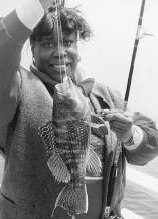
The Creation of a Marine Resource
New Jersey's reefs have come a long way in the past fifteen years. Prior to 1984, Sea Girt was the only active reef site off the Jersey coast and that site only had a half-dozen reef structures. Since then, the Department of Environmental Protection's Division of Fish and Wildlife developed a network of 14 reef sites, stretching from Sandy Hook to Cape May, and constructed over 1,300 fishing and diving reefs on these sites.
New Jersey anglers caught 48 million fish on ocean reefs in 2000
Both fish and fishermen have responded to this effort by the State. Considering only fishing trips for bottom species, such as sea bass, tautog and porgy, artificial reefs accounted for only 7 percent of the private and 3 percent of the party boat trips in 1970; with only a few artificial reefs in existence, the vast majority of bottom fishing occurred on the hundreds of shipwrecks sunk by storms, accidents and wars along the Jersey coast. In 1991, following initial reef construction efforts, use of artificial reefs rose to 42 percent of the private and 20 percent of the party boat bottom fishing activity. By 2000, following extensive reef building, reefs dominated the bottom fishing action, with 90 percent of private and 47 percent of party boat trips targeting bottom species occurring on reefs created by the Division. In other words, for anglers seeking bottom species like sea bass and tautog, private boat captains went to reefs 9 out of 10 trips and party boat captains preferred reefs 1 out of every 2 trips.
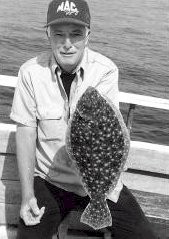
New Jersey's recreational wreck / reef fishing fleet now consists of 5,401 private, 240 charter and 64 party boats. During the course of the 2000 fishing season, one-third of a million angler-trips targeted wreck / reef species throughout the State's ocean waters. In 2000, these boats caught an estimated 7.9 million wreck/reef fishes, with 4.8 million of these being taken on our 14 ocean reef sites. The most important species in the catch was sea bass (5.6 million), followed by porgy (0.5 million), tautog (0.4 million) and fluke (0.3 million); 25 other species were caught in smaller numbers.
Fortunately, about 56 percent (4.4 million) of the fish caught were released alive. This season was marked by an outstanding run of sea bass that were represented by several strong year classes. For private boats, the Garden State North (28 fish/angler), Sandy Hook (24), Wildwood (23) and Atlantic City (21) reefs produced the best daily catches (includes kept and released, ) while Shark River (7), Great Egg (10) and Ocean Cit (13) reefs had the lowest catch rates. The catch rate for bottom fishing on wrecks not on reef sites was 24 fish per angler. National recreational fishing surveys estimated the State's total catch of all saltwater species averaged about 27 million fish annually during 1979-1999. Thus, the reefs accounted for 18 percent of all of the fish caught in Our state's salt waters.
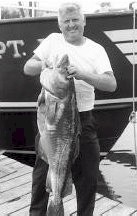
In other words roughly 2 out of every 11 fish caught along the Jersey shore during 2000 were caught on a reef built by the Division of Fish and Wildlife. This is a particularly amazing statistic given the fact that reef sites only comprise 0.3 percent of New Jersey's sea floor. "This survey demonstrates the importance of artificial reefs, " said Bob McDowell, Director of the Division of Fish and Wildlife. "The time and effort the Division has invested in developing our ocean reef network is now paying big dividends for New Jersey anglers. The Reef Program is creating a valuable new marine resource that will benefit the State's marine sport fishing industry for decades to come."
This information was collected as part of an intensive survey conducted between April and November, 2000. During this time, the Division interviewed 1,055 private and charter boat captains and 1,012 party boat anglers to obtain information about their fishing activities. We appreciate the support and cooperation of all the fishermen who participated in the study.
Scuba Diving Activities in New Jersey
In 2000, the Division of Fish and Wildlife conducted an intensive survey of reef and wreck fishing and diving activities. The results of the fishing portion of the study were reported in last year's Reef News. In comparison with angling, scuba diving in New Jersey has a much smaller number of participants, and both its harvest of marine species and consequent impact on the fisheries resources of reefs and wrecks is minimal.
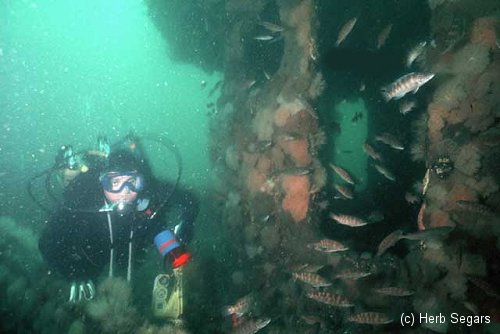
In 2000, New Jersey's recreational dive boat fleet consisted of an estimated 620 private and 38 charter boats. These vessels undertook a combined 2,664 dive trips in 2000, involving 19,728 divers who made 37,482 dives. Artificial reefs accounted for 62 percent of the private and 33 percent of the charter boat diving trips. The Sea Girt, Shark River and Cape May reef sites were the most popular. Sea Girt offers 23 shipwrecks, including a number of tugs used as check-out dives, in 60' to 80' depths. The Shark River Reef holds the largest reef wrecks, including the 460' USS Algol, which is frequented so often by New Jersey and New York dive boats that it is called "The Parking Lot." Shark River Reef wrecks lie in deep depths, up to 135', which require more experience from divers. The Cape May Reef provides 18 wrecks in an area of the coast that has fewer wrecks available to divers; the 157' Coast Guard buoy tender Red Oak has become the favorite dive attraction on this southern reef.
While fishermen are intent on catching fish, divers have other options available to them. Lobstering and spearfishing are important, representing 45 and 14 percent, respectively, of divers' primary interests, but observing marine life ( 18 percent ), photography ( 11 percent ) and artifact hunting ( 8 percent ) provide alternate non-consumptive activities.
While anglers caught an estimated 7.9 million fish on New Jersey wrecks and reefs during 2000, divers harvested relatively insignificant numbers ( in terms of fisheries management ) of fish and shellfish as shown in the table below.
Total estimated catch of New Jersey scuba divers in 2000
| Species | Unit | Total Catch |
| Sea Bass | Number | 3,436 |
| Tautog | Number | 5,081 |
| Summer Flounder | Number | 535 |
| Lobster | Number | 17,255 |
| Mussels | Pounds | 32,285 |
| Scallop | Number | 1,269 |
These articles first appeared in New Jersey Reef News - 2000 - 2003

